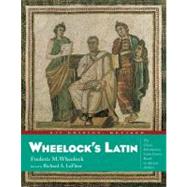The classic, single–volume introductory Latin textbook, introduced in 1956 and still the bestselling and most highly regarded textbook of its kind.
Wheelock's Latin, sixth edition, revised, has all the features that have made it the best–selling single–volume beginning Latin textbook, many of them revised and expanded:
- 40 chapters with grammatical explanations and readings based on ancient Roman authors
- Self–tutorial exercises with an answer key for independent study
- An extensive English–Latin/ Latin–English vocabulary section
- A rich selection of original Latin readings –– unlike other textbooks which contain primarily made–up Latin texts
- Etymological aids
Also includes maps of the Mediterranean, Italy and the Aegean area, as well as numerous photographs illustrating aspects of classical culture, mythology, and historical and literary figures presented in the chapter readings.
- The leading self–tutorial Latin program. Also great for college and accelerated high school courses.
- Wheelock's Latin is the top–selling Latin reference in the US.
- Interest and enrolments in Latin have been steadily rising in the U.S. for the past 20 years. One–half million people are currently enrolled in Latin classes, and at least 10,000 teachers, professors and graduate assistants are teaching the language in America.
“LaFleur has done a great service for the study of Latin: this revised edition ensures the survival of a textbook that has remained on the academic bestseller lists for more than forty years. The expanded grammatical explanations are particularly valuable for today’s students and teachers.”-Professor James M. May, ST. Olaf College








